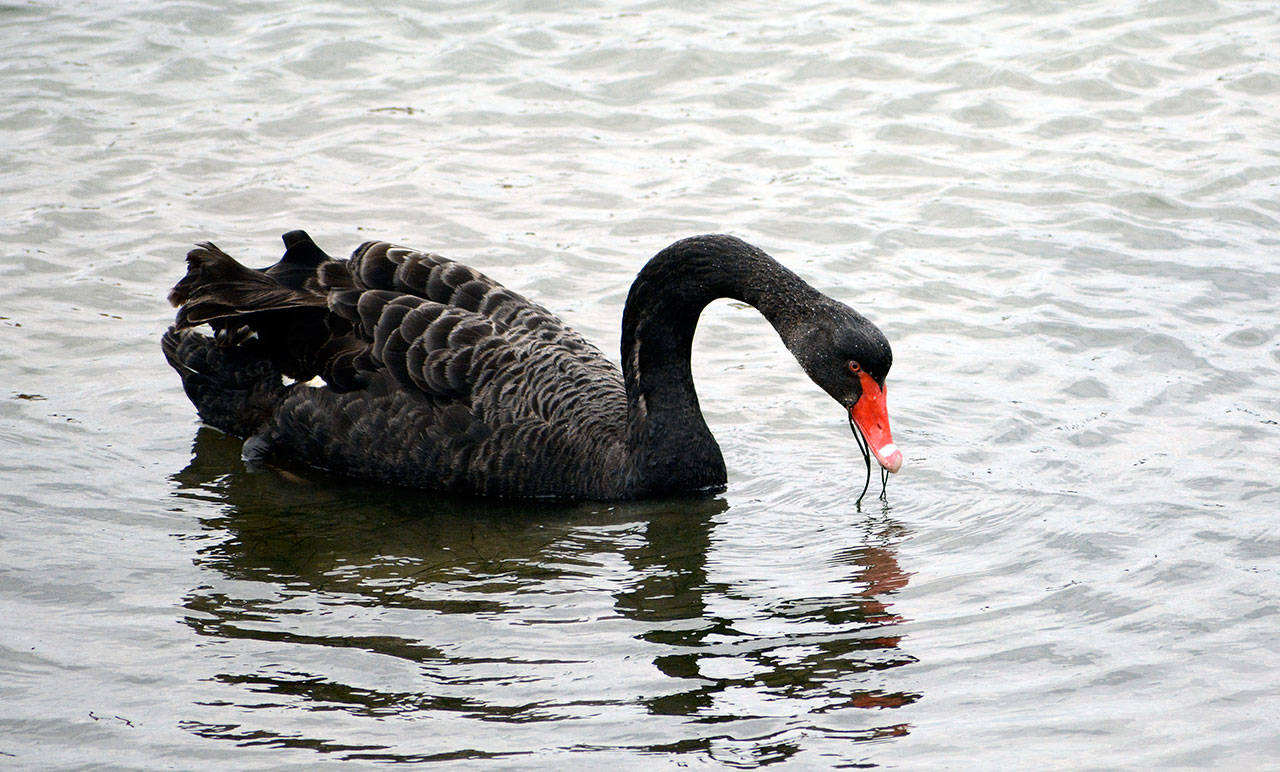A bit of a change in venue here as this bird has been hanging out at the Tokeland Marina for a few months, and that is Pacific County, but not too far outside my chosen area and easily within a birder’s jurisdiction. I have tried (unsuccessfully) to find it just once but am assured by the locals that it is still there in the area, so I will try again. Meanwhile, Judith Taylor found it and took this lovely photo. Enjoy!
General Description: Black Swans are native to southwestern and eastern Australia, so this swan is most likely a pet, an escapee from someone’s yard. This bird is mostly black with some white flight feathers, just visible on its sides in the photo, a long neck, a red bill with a light-colored bar across the lower end and a light tip below that. The male (cob) is slightly larger than the female (pen) at forty-three to fifty-six inches in length, with wingspans of five foot two to six foot six feet and weighing 8.2 to 19.8 pounds. It is a graceful-looking bird which has a high popularity in formal gardens and ponds. I originally thought this swan was native to the U.K. because we so often see them in formal English gardens. It is also seen in city parks, waterways and nature centers and is considered an exotic bird.
Habitat: In their native environment these swans inhabit wetlands where some areas support large populations of them. In the countries where they have been imported, they can be found in lakes, ponds, rivers and city parks. They prefer permanent wetlands including ornamental lakes, but they can also be found in brackish and salt-water lakes, swamps and rivers. They can also be found in flooded pastures and tidal mudflats, which is where Tokeland Marina comes in, and occasionally on the open sea near islands or near shore.
Behavior: Black Swans spend most of their time feeding and will feed off the bottom of bodies of water if shallow enough for their neck to reach that far. If water is too deep, they will upend like a dabbling duck. They have a musical and far-reaching, bugle-like call and vocalize on the water or while flying. They also have a series of softer sounds, almost crooning, and if disturbed while breeding or nesting they may even whistle. In their native environment they can be found singly or in large groups numbering in the hundreds or even thousands. Black Swans are unusual in that one quarter of all pairings are homosexual, mostly between males. They may even drive females off a nest containing eggs and take over the nesting duties. When swimming, they hold their necks arched and often carry their feathers or wings raised in an aggressive display.
Diet: In their native habitat, Black Swans eat aquatic and marshland plants and that’s what they look for wherever they are. Though they may not find their favorite foods here (reedmace leaves), they have learned to make do with submerged algae and local grasses and water weeds.
Nesting: Like other swans, the Black Swan is largely monogamous, pairing for life. It has recently been found that a third of all broods exhibit extra-pair paternity. Male pairs will steal nests or form a temporary threesome with a female, driving her away after she lays eggs in her nest and raising the cygnets themselves. The nest is a large heap of reeds, grasses and weeds between three and four feet in diameter and about three feet high in shallow water or on islands. The female lays four to eight eggs, then both sexes incubate the eggs (with the female having the night duty) for 35 to 40 days. After hatching the cygnets are tended by both parents for about nine months until fledging. The nest is rebuilt or reused each year.
Migration: Within Australia Black Swans are nomadic, with erratic migration patterns dependent on climate conditions. As the Australian continent heats up and the wetlands disappear, they may be facing severe tests of their ability to find the right place to settle.
Conservation Status: Populations outside Australia seem to be doing OK, but not really well, with successful breeding going on in Lakeland, Fla. for one. The population in Britain is not considered to be self-sustaining, with only nine breeding pairs as of 2001 and an estimate of 43 feral birds in 2003-2004. There are not many reports of this bird in North America, so I cannot say how they are doing here. There are large numbers in New Zealand and good numbers in Tasmania, and of course they are common in Australia.
When and Where To See on Twin Harbors: This swan can be seen in and around the Tokeland Marina, with best viewing at low tide. It will be foraging on the algae and seaweeds along the edges of the marina and around the rocks in the area. Please respect the private property of the residents in that area.



